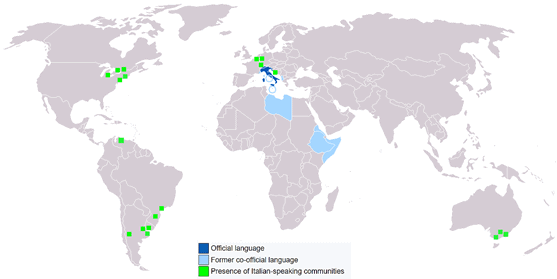Spanish and Italian are commonly seen as closely related, due to their cultural similarities. They are both Catholic by culture, both have a passion for good food, both are fairly easy languages to learn, and both are family-orientated. Apart from their cultural similarities, Spanish and Italian languages are also perceived as quite similar for many non-native speakers around the world. But the trained linguist can pick up on the differences beyond their similarities.
🇪🇸 Spanish vs 🇮🇹 Italian: Which One is Spoken the Most?
While the Italian language has more native speakers in Europe (approximately 70 Million) than with the Spanish language (approximately 50 million). Spanish is still considered the more global language, as it spoken in most of South America, and is therefore treated as the dominant one between them. Spanish is the official language of 21 countries globally, while Italian is the official language in 4 countries. Take a look at these maps of the geographical distribution of Spanish and Italian speakers around the world.
Map of Spanish Speakers Around the World

Map of Italian Speakers Around the World

There are around 483 million Spanish native speakers around the world, which makes it the second most important native language after Mandarin (Chinese). Italian is the 20th most spoken language, with an additional 3 million being non-native Italian speakers that are spread around in small communities. It can be seen that Italian speakers are more concentrated in Europe while Spanish speakers have a wider geographical distribution.
Similarities between Italian & Spanish
Spanish and Italian are both Romance languages. This means that they are derived from the language of the Roman Empire – Latin. Historically, after the collapse of the Roman Empire around the 5th century, dialects of “Vulgar Latin” or “Late Latin” began to circulate over time in some Roman territories and can be differentiated for formal written Latin with its firm rules. This is what puts them in the same language family of “Romance” languages, and why they have so much in common in comparison to other languages.
Sentence Construction
Spanish and Italian, share similar sentence orders. Both have a basic sentence structure of (subject-verb-object) – like in English.
| English | Kimberly fed the dog. |
| Spanish | Kimberly alimentó al perro. |
| Italian | Kimberly alimentato il cane. |
Plurals
There are Plurals and agreement between nouns and adjectives with a final vowel.
| Singular | Plural | |
| English | Friend | Friends |
| Spanish | Amigo | Amigos |
| Italian | Amico | Amici |
Grammatical Genders
Both use grammatical gender (masculine and feminine) with agreement between nouns and adjectives in gender. The markers are often o (masculine) and a (feminine).
| Masculine | Feminine | |
| Spanish | Amigo | Amiga |
| Italian | Amico | Amica |
Conjugation
Both use Conjugation (even though there may be some difference in their rules), with majority of the same ones being used (including the subjunctive).
Italian Conjugations
| Parlare | Vendere | Partire | |
| 1st person singular | Parlo | Vendo | Parto |
| 2nd person singular | Parli | Vendi | Parti |
| 3rd person singular | Parla | Vende | Parte |
| 1st person plural | Parliamo | Vendiamo | Partiamo |
| 2nd person plural | Parlate | Vendete | Partite |
| 3rd person plural | Parlano | Vendono | Partono |
Spanish Conjugations
| Hablar | Vender | Partir | |
| 1st person singular | Hablo | Vendo | Parto |
| 2nd person singular | Hablas | Vendes | Partes |
| 3rd person singular | Habla | Vende | Parte |
| 1st person plural | Hablamos | Vendemos | Partimos |
| 2nd person plural | Habláis | Vendeís | Partís |
| 3rd person plural | Hablan | Venden | Parten |
Formality
Using formality (speaking to an older person, or a stranger).
| Formal | Informal | |
| Spanish | ¿Cómo se llama? | ¿Cómo te llamas? |
| Italian | Come si chiami? | Come ti chiami? |

Differences between Italian & Spanish
While many instances of both languages may have similarities, its only when you learn the language in more detail that you will start to find the differences that distinguish them apart. Here some notable differences:
Double Consonants
Most vowels and consonants in Spanish and Italian are pronounced the same. Both languages use vowels a lot, with triphthongs being often. For example – Italian: ”Che vuoi fare?”/ Spanish: ”¿Qué queríais hacer?” (What do you want to do?). In both languages, the voiceless consonants /p/, /t/ and /k/ are less aspirated than in English. Also the /t/ is made by putting the tongue against the upper teeth. However, the voiced consonants /b/, /d/ and /g/ differ. The Italian versions are similar to English, although the voicing is more pronounced than Spanish. Spanish /b/ is indistinguishable from /v/and is made using the lips. When /d/ appears between vowels in Spanish, it becomes like the sound at the beginning of the English word ‘this’. When /g/ appears between vowels, it becomes softer.
Italian contains many, many words with doubled consonants, such as: gabbia, bocca, addio, baffi, leggo, bello, gomma, anno, scoppiare, correre, adesso, gatto, avverbio, azzurro.
When a consonant is doubled in this way, the sound is lengthened and thus emphasized more in speech. In Spanish, on the other hand, the only consonants which can be doubled are ‘l’ (llamar) and ‘r’ (perro). The Spanish ‘rr’ is similar to the Italian version, but ‘ll’ is a sound in its own right as described above. (It is also possible to have ‘cc’ in Spanish, as in acción, but this is not a true doubling as the first ‘c’ is hard and the second is soft.)
Here are some examples of some similarities between Spanish words and Italian words with audio, so you can hear how they can still be pronounced differently:
Sol (Spanish) – Sun:
Sole (Italian) – Sun:
| English | Spanish | Italian |
| Fruit | Fruta | Frutta |
| Sun | Sol | Sole |
| Person | Persona | Persona |
| Thing | Cosa | Cosa |
| Good | Bueno | Buono |
| Difficile | Difícil | Difficult |
| Black | Negro | Nero |
| Vegetable | Verdura | Verdura |
| Bicycle | Bicicleta | Bicicletta |
| Open | Abrir | Aprire |
Verb Conjugations
The conjugation rules in Italian and Spanish have similarities, however precise rules are distinguishable. The core difference is that Italian verbs tend to end in vowels in all their conjugations, while Spanish typically ends with an “s” or “n”. Verbs categorized and grouped in similar ways. Both languages have three main groups of verbs (Spanish verbs ending in ar, er, and ir), and (Italian verbs ending in are, ere and ire); verbs can be grouped into other major groups as well. Italian and Spanish have the usual set of conjugations found in Romance language.
No te preocupes (Spanish) – Don’t worry:
Non preoccuparti (Italian) – Don’t worry:
| English | Spanish | Italian |
| What do you want? | ¿Qué queríais hacer? | Che vuoi fare? |
| Let us drink | Bebamos | Beviamo |
| Don’t worry | No te preocupes | Non preoccuparti |
| Please come in! | ¡Por favor entra! | Prego entra! |
| I want to buy food | Quiero comprar comida | Voglio comprare del cibo |
You can now see how the Spanish verbs end with “s” like bebamos or contain one of the verb groups such as “er” like hacer. This is in comparison to the Italian verbs that end with vowels like “o” in Beviamo and use the verb groups like “are” in fare. These are the most pronounced grammatical differences and similarities in rules between Italian and Spanish.
Simple Past Tense (Preterite vs Perfect tense)
In Spanish, to express the past tense, the simple past tense is more often used. In Italian, especially in conversation, the perfect tense is used. One of the best ways to learn Italian or Spanish, is by understanding the grammar.
| English | Spanish (simple past tense) | Italian (simple past tense) |
| I went to the movies | Fui al cine | Sono andato al cinema. |
| I did not shoot the Sheriff | Le disparé al alguacil pero no le disparé al ayudante | Ho sparato allo sceriffo ma non ho sparato al vicesceriffo. |
Italian does use simple past tense, but it is mainly in the formal written form such as in newspapers and books. In reading, it’s important to recognise the tense with common verbs like essere and avere, especially as those are not regular. In Spanish, the perfect tense is used to indicate completion. If you said “He disparado al alguacil”, it would mean “I have shot the sheriff”. It doesn’t just refer to the past. Also, in Spanish, the perfect tense is always formed with haber.

Pronunciation
There are a few pronunciation differences that you must know between Spanish and Italian, as this is what will help distinguish similar looking words and sentences. Check them out below:
| Italian and Spanish Pronunciations | Example |
| Italian can have consonants following the letter “s”, and Spanish cannot. | Spaghetti is the same in both Italian and Spanish, and it’s espaguetis in Spanish. |
| Spanish tends to have many more “s” sounds, making it hissy sounding. | ¿Vosotros queréis esperar aquí unos cuantos minutos mientras que te preparamos unos cafes? (Do you want to wait here a few minutes while we make you some coffees?) |
| Italian has double letters in most of its words, and they’re pronounced with emphasis. Spanish has fewer of these. | Apartamento (Spanish)/ Appartamento(Italian) / Apartment (English) |
| Spanish tends to accentuate the trilled “r” when it’s doubled. The emphasis is not as strong in Italian. You can also find a double “n” in some spellings. You can find a double “c” in some words, but each letter is pronounced distinctly | Correr or after a consonant, Alrededor. Connotación Diccionario, where it’s pronounced “dik-thionario” or “dik-sionario”). |
A great example is the difference in the usage of the letter “s” in both languages’ pronunciations. Italian has consonants following the letter “s” and Spanish cannot, but Spanish ahs many more “s” sounds in its sentences. These are some of the crucial little details that make a difference!
Formalities
Formality rules between these languages also have some distinguishable rules.
| Spanish | Italian |
| Spanish treats its language formality is fairly consistently globally, with a few exceptions (like the countries that use vos). | Italian has the pronoun ”Lei” for “you, formal”. |
| Spanish uses the ”usted” singular formal second person pronoun (“you formal”), which is conjugated the same as “he/she”. | Lei is always capitalised, to distinguish it from the pronoun lei, which means “he” – which is also conjugated the same. |
| Spanish also has ”ustedes” for the plural form of “you formal”. | The pronoun ”voi” which normally is the plural of ”tu” (i.e. “you plural, informal”) is also used as a form of respectful address to one person, particularly in the south of Italy. |
The social rules on when to use ”Lei” and ”usted” are essentially the same between Italian and French-speaking cultures. You can use the formal pronoun with someone you don’t know who’s of adult age or above and for someone much older than you, even when you know them well. But you would rarely use formal pronouns with someone much younger, or between two young people in casual situations.

Pro & Cons of Spanish & Italian
If you are wondering which language between these two is the one for you, here are some pros and cons for each to help you make a decision.
Spanish
| Pros of Learning Spanish | Cons of Learning Spanish |
| Spanish is much more widely spoken all over the world than Italian, making it a much more practical language to learn | It takes time to learn this language. So it is important to not give up when it feels like it might be too long |
| Spanish has many more resources to help you learn the language better than Italian, as it is more widely used world-wide | It can be difficult, like learning any other foreign language, so you need to commit and push yourself when things get hard. |
| There a lot of vacancies for Spanish tutors around the world, because the language is growing and is popular | You might lose interest in your local language |
| You will be able to better enjoy and experience Spanish culture and media like music and films |
Italian
| Pros of Learning Italian | Pros of Learning Italian |
| Italian is one of the most flexible and complex languages in the world. By learning its grammar and structure will improve your ability to understand and speak other Romance languages like Spanish and Portuguese, so it is highly beneficial. | It is a difficult language to master, especially if you do not have interest in it. |
| It makes use of a lot of English vocabulary, so it is beneficial if you are a native English speaker | It is not as widely spoken as Spanish, which makes it more of a niche language in comparison. |
| You will be able to deeply appreciate and experience Italian culture, art and literature. |
There are some convincing arguments to learn either Spanish or Italian, but ultimately it depends on your interest and preference. It is up to you on which language you feel you will greatly enjoy and benefit from.

🇪🇸 Spanish vs 🇮🇹 Italian: What’s Your Choice?
After reading this article, you undoubtedly see the similarities and differences between both the Spanish and Italian languages, and know the best ways to learn a new language. Both have many links between each other and also key distinguishing grammatical and structural rules. However, due to their history, they are both Romance languages. Therefore, learning one of these will surely help you down the line, if you also want to learn the other. It all depends on which one you are passionate for!
















